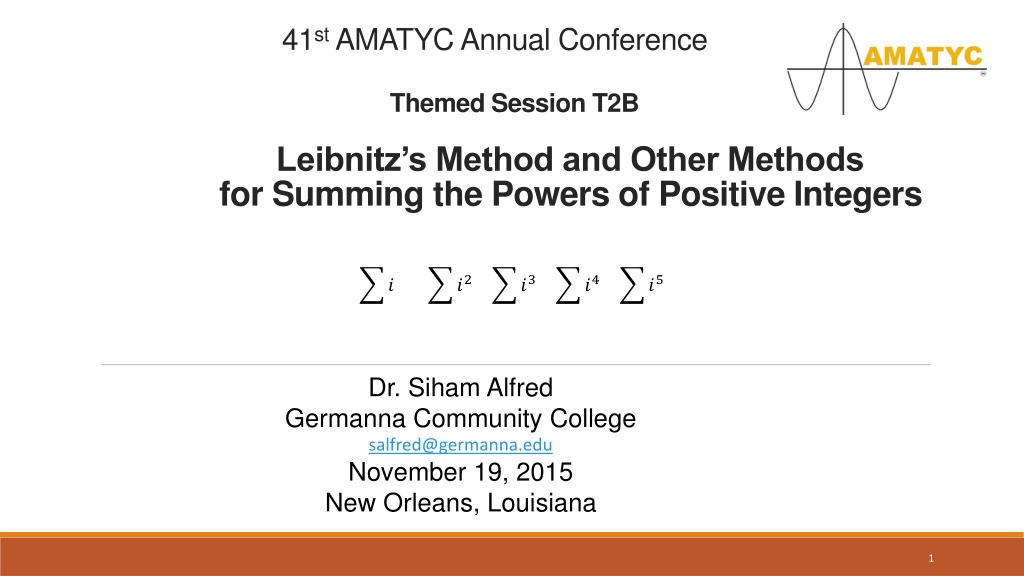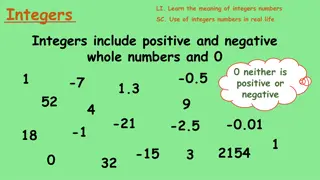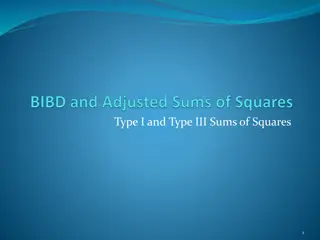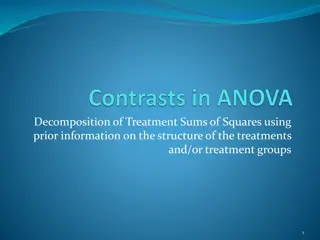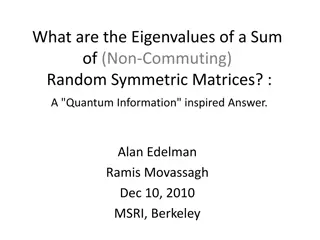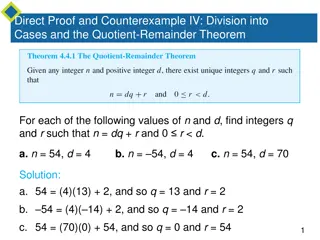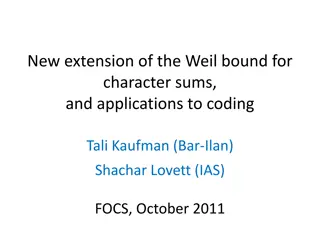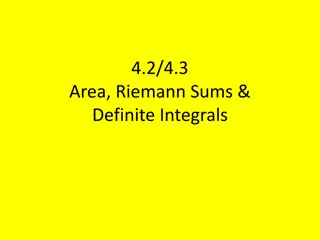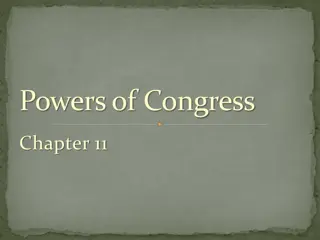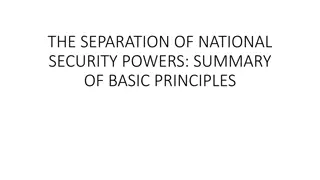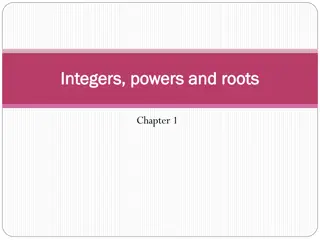Exploring Sums of Powers of Positive Integers Through Leibnitz's Method
Students are introduced to the computation of sums of powers of positive integers through Leibnitz's Method and other techniques in the context of finding areas under curves and exploring integration. The presentation delves into the origins of these formulas and their computation, reflecting on the historical figures who contributed to this mathematical exploration.
Download Presentation

Please find below an Image/Link to download the presentation.
The content on the website is provided AS IS for your information and personal use only. It may not be sold, licensed, or shared on other websites without obtaining consent from the author. Download presentation by click this link. If you encounter any issues during the download, it is possible that the publisher has removed the file from their server.
E N D
Presentation Transcript
41stAMATYC Annual Conference Themed Session T2B Leibnitz s Method and Other Methods for Summing the Powers of Positive Integers ?2 ?3 ?4 ?5 ? Dr. Siham Alfred Germanna Community College salfred@germanna.edu November 19, 2015 New Orleans, Louisiana 1
Abstract Students are introduced to sums of powers of positive integers when finding areas under curves to motivate the introduction of integration. They begin to approximate areas under curves by using right-Left hand side rectangles, midpoint or trapezoid methods. All these calculations are done for small values of n. When they proceed to calculate the area as a limit of a Riemann Sum, they encounter the formulas for the sums of powers of positive integers. 2
Abstract Or they might encounter these formulas in a course on Mathematical Induction. But where do these formulas come from and how are they computed remains a mystery to the students. In this presentation primarily Leibnitz s Method and some modifications his method for calculating sums of positive integer powers will be explored. 3
On Finite Sums of Powers of Positive Integers OUTLINE I. The Sum of the First n Positive Integers II. The Leibnitz Algebraic Method A. Alternative Algebraic Method B. Calculus-Based Method C. Looking at the General Case 4
Some Powers of Positive Integers n = (1) 1 n i + ( 1) 1 2 1 2 n n n = + 2 i n n (2) = = 2 1 i + + 1 3 1 2 1 6 ( 1)(2 6 1) n n n n + + = 3 2 2 n n n (3) i = = 1 i + 2 2 1 4 1 2 1 4 ( 1) n n n + + = 4 3 2 3 n n n i (4) = 4 = 1 i + + + 2 1 5 1 2 1 3 1 30 ( 1)(2 1)(3 30 3 1) n n n n n n + + = 5 4 3 4 n n n n i = (5) i 5
Mathematicians who computed the sums of powers of positive integers See Janet Beery s valuable article in [2]. Beery traces the fascinating and rich history of the computation of the sums of powers of positive integers from Pythagoras to Bernoulli. 6
Mathematicians who computed the sums of powers of positive integers Pythagoras (570-500 B.C.) Greece, Italy Archimedes (287-212 B.C.), Greece, Italy Aryabhata (b. A.D. 478) Northern India Abu-Bakr Al-Kharaji (d. 1019) Baghdad Ibn Al Haytham (965-1039) Egypt Thomas Harriot (1560-1621) England Johann Faulhaber (1580-1635) Germany Pierre de Fermat (1601-1665) France Blaise Pascal (1623-1662) France Jakob Bernoulli (1654-1705) Switzerland 7
I. The Sum of the First n Positive Integers + ( 1) n n n = i = 2 1 i 1 1 + 2 = 3 1 + 2 + 3 = 6 1 + 2 + 3 + 4 = 10 8
The Pythagorean Method of Computing the Sum of n Positive Integers 2(1 2 3 4 5) + + + + = 5 6 Twice a triangular number is an oblong number: 2(1 2 3 ... ) n + + + + = ( (1 2 3 ... ) 2 + ( 1) n n 1) + n n + + + + = n Generalize this result to get the sum of the first n positive integers 9
Leibnitz Experimented with Finite Differences In [3] on page 31, Leibnitz computes finite differences on the set of squares below 0 1 4 9 16 25 1 3 5 7 9 and notes that 25 - 0 = 1 + 3 + 5 + 7 + 9 He notes that this sum: first term minus the last term of the original sequence is the sum of the first differences no matter where one starts. For example: 25 1 = 24 = 3+5+7+9 10
Leibnitz Experimented with Finite Differences he called combinatory numbers. In this array a preceding series, whether horizontal or vertical, is the first difference of the series immediately following it. In addition, each series either horizontal or vertical contains the sum of the series immediately preceding it 1 1 1 1 1 1 In this array a preceding series whether horizontal or vertical is the first difference of the series immediately following it. Then he proceeds to study 2nd, third and fourth finite differences on the set below which 1 2 3 4 5 6 1 3 6 10 15 21 1 4 10 20 35 56 Each series either horizontal or vertical contains the sum of the series immediately preceding it. 1 5 15 35 70 126 1 6 21 56 126 252 1 7 28 84 210 462 11
He argued in [3] page 51 that if x is the general term of a series of natural numbers, then the general term of the series of squares is be ( 1) x + . Then the general term for the finite difference between the two successive + = + , which an odd number. Similarly the general term for the finite difference of successive cubes is ( 1) 3 3 1 x x x x + = + + . Then Leibnitz applied the same approach he used on the two successive terms of squares and cubes and considered computing the difference between two successive terms of the entire series as will be shown next. 2x and the next square in the series would 2 2 2 squares is ( 1) 2 1 x x x 3 3 2 12
II. The Leibnitz Algebraic Method + + ( 1)(2 6 1) n n n n = The sum of the first n integer squares = 2 i = 1 i As a polynomial, it will be shown that the above sum can also be written as + + 3 2 ( 1)(2 6 1) n n n n n n n = = + + 2 i 3 2 6 = 1 i 13
II. The Leibnitz Algebraic Method Leibnitz made the assumption that the sum of squares of the first n integers is a polynomial of degree n+1. So by assumption the sum of the first n squares is a cubic polynomial ?(?) = 02+ 12+ 22+ 32+...+?2= ??3+ ??2+ ?? + ? Since S(0) = 0it follows that d = 0 14
II. The Leibnitz Algebraic Method ?(? + 1) = 02+ 12+ 22+ 32...+?2+ ? + 12 Consider + = + = + + 2 2 ( 1) ( ) S x ( 1) 2 1 S x x x x It is clear that The left hand side can be written as: + + + + + + = + + 3 3 2 2 2 [( 1) ] [( 1) ] [( 1) ] 2 1 a x x b x x c x x d d x x 15
II. The Leibnitz Algebraic Method Expanding the Left hand side and collecting like terms gives + + 2 ) b x a b c + + + = + + 2 2 3 (3 2 1 ax a x x Equate coefficients of like terms 3 1, 3 a = + = + + = 2 2 1 a b and a b c to get 1 1 1 = = = , a b and c 3 2 6 + + ( 1)(2 6 1) x x x as required to prove 1 1 1 = + + = 3 2 ( ) S x x x x 3 2 6 16
Use S(x) = ax2 + bx + c S(0) = 0, so c = 0 For the sum of the first n integers ( 2 i = S(x+1) S(x) = (x+1) = a[(x+1)2 x2 ] +b[(x+1) x]+ c c = 2ax + a + b = x + 1, a = , b = + 1) n n n = i 1 S(x+1) S(x) = (x+1)3 = a[(x+1)4 x4 ] +b[(x+1)3 x3] + c[(x+1)2 x2 ] + d[(x+1) x] = (x+1)3 = 4ax3 + (6a+3b)x2 + (4a+3b+2c)x +a+b+c = (x+1)3 = x3 + 3x2 + 3x + 1 For the sum of the first n cubes Use S(x) = ax4 + bx3 + cx2 + dx S(0) = 0, so e = 0 + 2 2 ( 1) n n n = 3 for i 4 = 1 i 4a =1, 6a + 3b = 3, 4a + 3b + 2c = 3 a = , b = , c = , d = 0 S(x+1) S(x) = (x+1)k For the sum Use S(x), a polynomial of degree k+1 for a positive integer k 17
A.Alternative Algebraic Method Note: Leibnitz Method requires expanding the binomial powers of (x+1). An alternative method would be equating two polynomials which requires equating coefficients of like terms. + + + + + + = + + 3 3 2 2 2 [( 1) ] [( 1) ] [( 1) ] 2 1 a x x b x x c x x d d x x Since we have three unknowns we need three equations to solve the system. When x = 0 the above equation becomes a b c + + = 7 3 a b c + 5 a b c + 1 + = + = When x = 1 the above equation becomes 4 9 19 When x = 2 the above equation becomes 18
A.Alternative Algebraic Method When solving the system the same solution is obtained 1 1 1 = = = , a b and c 3 2 6 19
B.Calculus Based Method By the time the students get to Riemann sums and integration they have already covered the derivative, they can differentiate both sides of the equation in Example 1 + + ] + x + + + = + + 3 3 2 2 2 (1) (2) [( [3( a 1) 1) + ] [( b 1) + ] [( 2 1) 2 ] 2 1 a x x 3 b x + x c x = x d d x x + 2 2 [2( 1) 2 ] x x x x (2) is an equation in a and b, the c term vanishes. Note that the term in (2) + 1) 2 ] 2 x = + = [2( b 2 2 2 x bx b bx b + ] 2 + = 2 2 So equation (2) becomes [3( a 1) 3 2 2 x x b x 20
B.Calculus Based Method Differentiate equation (2) again will eliminate the constant term 2b to get + 1) 6 ) = (6 2 a x x (3) When x = 0 in equations (1), (2) and (3) the system can be easily solved by back substitution + + = + = 1 a b c a 3 2 2 b 1 1 1 = = = = 6 2, , , a So a b and c 3 2 6 21
C.Proving the General Case To prove the general case that the sum of positive integer powers of k = + + + + + = 1 1 k + ( ) 0 1 2 3 .... S x x = + + + + + = k + + + + + + 1 1 k k k k k k k , is a polynomial of ... a x a x a x a x a ( ) S x 0 1 2 3 ... x + 1 1 1 k k k o a = , assume that 0 += degree k+1 with and ka 0 1 = + + + + + 1 2 m m m k k k k k ( ) ... an arbitrary P x a x a x a x a x a 1 2 1 m m = m o + , the leading coefficient of ( ) th P x m degree polynomial. It is required to show that 1 1 k + Since (0) 0 S = , it follows that 1 m k a = . 0 = and the constant term a 0 m a = . 0 0 + = + = + + + ] ... + + + 1 1 k m m m m ( 1) ( ) S x ( 1) [( 1) ] [( 1) [( 1) ] S x x a x x a x x a x x 1 1 m m 22
C.Proving the General Case the leading term of the polynomial on the x+ k = + as required to prove. 1 1 m + kx = 1 1)k 1 1 k m ( ) m a x It follows that the leading term of ( k is m = and 1 m m left. Therefore = = = Moreover, 1 ( ) m a m a and namely that the leading coefficient of the sought after m polynomial of degree k+1 is the reciprocal of the degree of the polynomial as required to prove. 23
Leibnitzs Method and Other Methods of Summing Up the Powers of Integers REFERENCES 1. J.A, Suzuki, Introducing the Sums of Powers , The College Mathematics Journal, Vol. 35, No. 4, September 2004, pp. 303-305 2. J. Beery http://www.maa.org/press/periodicals/convergence/sums-of-powers-of-positive-integers 3. G.W. Leibnitz (Translated by J.M. Child), The Early Mathematical Manuscript of Leibnitz, Open Court, 1920, pp. 31-33, 51 24
